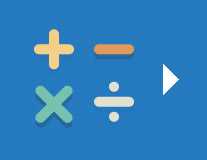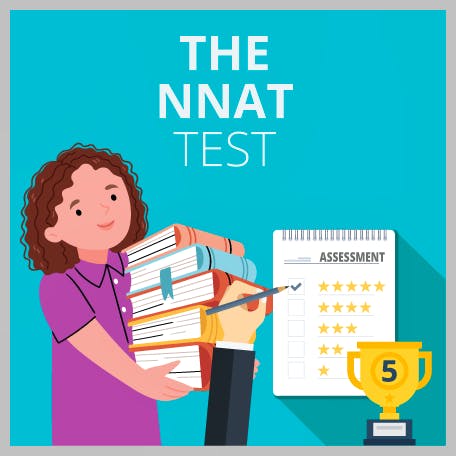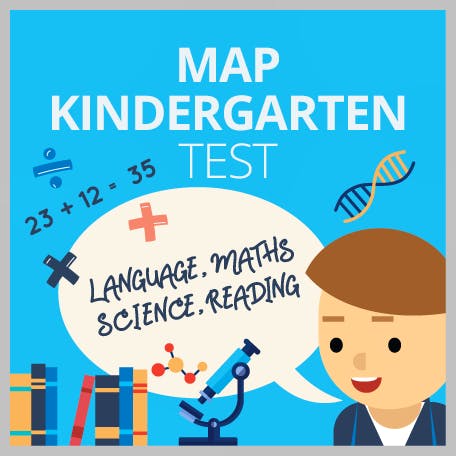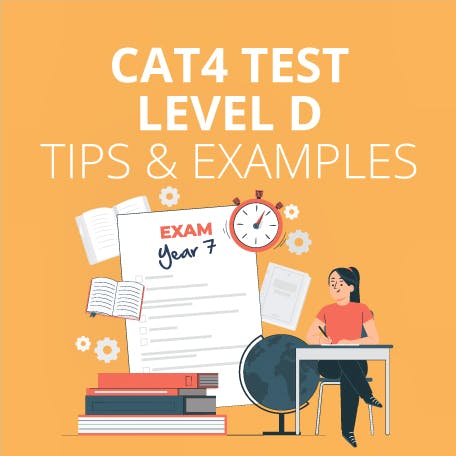A Guide to the OLSAT Test: Examples & Tips
Updated November 18, 2023
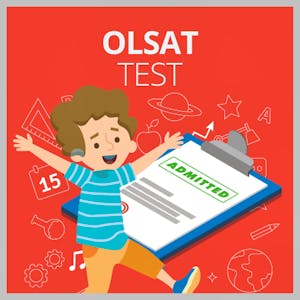

OLSAT stands for Otis-Lennon School Ability Test.
Children take the test to help schools decide admissions into their gifted-and-talented programs.
Preparing your children for taking the OLSAT is a good idea as it could determine their eligibility and acceptance to extra academic programs that are offered by their schools.
What Is the OLSAT Test?
The OLSAT is a multiple-choice test designed to identify highly gifted children.
It is considered a reliable measure of intelligence as shown through speed of thought and reasoning ability. It is sometimes referred to as the OLSAT IQ test.
The OLSAT is designed to be difficult.
The purpose of the OLSAT is to help schools see how they perform as institutions of learning as well as to identify gifted-and-talented young people.
The OLSAT test was developed by Pearson Education and was first devised in 1979 by creators Arthur Otis and Roger Lennon.
It’s currently in its eighth edition; the OLSAT 8 has continually been peer-reviewed since its inception to remove any gender, ethnic, regional and cultural biases.
You can speak to your child’s teacher if you would like them to take the OLSAT.
Only those who are expected to perform at the highest level are normally put forward for it.
It can be taken at any age so it’s best to wait until your child is mentally ready and prepared for it.
What Is the OLSAT Exam Format?
The OLSAT takes 60–77 minutes to complete.
For older children, it is usually group administered. Younger children take the OLSAT on a one-to-one basis, with an administrator reading the questions.
There are two main sections to the OLSAT:
- Verbal
- Non-verbal
Within the verbal section, there are tests on comprehension and reasoning.
Within the non-verbal part, there are pictorial reasoning, figural reasoning and quantitative reasoning tests.
Attention to detail is crucial in understanding the differences between these.
Each OLSAT level is designed to include both verbal and non-verbal sections, although some schools or districts choose to only use one section.
For example, New York City uses only the verbal portion of the OLSAT.
The OLSAT has various levels (A to G) depending on the age or grade of the tested students.
Students are assigned to a test level depending on which grade they are in.
As a rule of thumb, the early levels are for younger students, and the higher levels are for the older. This article will outline each of these levels in turn.
Kindergarten: Level A
This initial OLSAT level targets children in Pre-K or Kindergarten.
The tests are usually administered one-to-one, with the test administrator reading out the questions.
The test administrator can only read each question once so it’s important that the children being tested are encouraged to listen and focus.
Younger, pre-K students have 40 questions to answer in a total time of 77 minutes.
Kindergarteners have more questions to answer (a total of 60) in the same time limit of 77 minutes.
The topics that the questions cover are:
- Following directions
- Figural series
- Figural classification
- Figural analogies
- Picture classification
- Picture analogies
- Picture series
- Pattern matrix
- Aural reasoning
- Arithmetic reasoning
First Grade: Level B
For Level B there are 60 questions to answer in the time limit of 77 minutes.
These are also read aloud, as reading age can vary a lot at this grade level.
The topics covered here are:
- Figural series
- Following directions
- Aural reasoning
- Arithmetic reasoning
- Figural analogies
- Figural classification
- Picture matrix
- Picture classification
- Picture analogies
Second Grade: Level C
At this level, some questions are read aloud by the administrator while others are completed independently by the child.
This level also has 60 questions to answer in the time limit of 77 minutes (split equally between verbal and non-verbal).
Subjects covered in this assessment are:
- Figural classification
- Figural analogies
- Figural series
- Following directions
- Aural reasoning
- Arithmetic reasoning
- Pattern matrix
- Picture classification
- Picture analogies
Third Grade: Level D
At this stage, the children are eight years old and are expected to read by themselves. Therefore, the 3rd grade OLSAT test is the first OLSAT level where the children are completely independent in answering their questions.
There are 64 questions (equally split between verbal and non-verbal) with 50 minutes to answer them.
The topics covered in the assessment are:
- Verbal analogies
- Verbal classification
- Antonyms
- Sentence completion
- Sentence arrangement
- Arithmetic reasoning
- Logical selection
- Word and letter matrix
- Number series
- Numerical) inference
- Number matrix
- Figural classification
- Figural analogies
- Pattern matrix
- Figural series
Fourth & Fifth Grades: Level E
At this level, the OLSAT can help distinguish students who would benefit from specialized middle schools.
There are 72 questions to be taken within 60 minutes.
For Level E, the topics are:
- Sentence completion
- Sentence arrangement
- Antonyms
- Inference
- Arithmetic reasoning
- Logical selection
- Word and letter matrix
- Verbal analogies
- Verbal classification
- Figural series
- Number series
- Figural analogies
- Pattern matrix
- Number matrix
- Numerical inference
Sixth, Seventh & Eight Grades: Level F
The penultimate level covers three grade levels and is aimed at children aged 11–13.
There are 72 questions to be answered over 60 minutes of test time.
They cover these subjects:
- Word and letter matrix
- Verbal analogies
- Verbal classification
- Antonyms
- Logical selection
- Sentence completion
- Sentence arrangement
- Arithmetic reasoning
- Number series
- Numerical inference
- Number matrix
- Inference
- Figural analogies
- Figural series
- Pattern matrix
Ninth to Twelfth Grades: Level G
The final OLSAT level is the hardest, so practicing becomes crucial.
It targets students aged 14-16.
There are again 72 questions to be answered over 60 minutes of test time, covering the following topics:
- Logical selection
- Word and letter matrix
- Antonyms
- Sentence completion
- Sentence arrangement
- Arithmetic reasoning
- Inference
- Verbal analogies
- Verbal classification
- Pattern matrix
- Figural series
- Number series
- Figural analogies
- Numerical inference
- Number matrix
OLSAT Practice Test Questions
There are 21 different types of questions over the seven OLSAT levels.
Not all questions will be present at every level. For example, questions that assess the ability to follow directions are only in the early levels (A to C).
Questions do not go from easy to hard within each test like they might in other types of assessments – typically, the easier and harder questions in the OLSAT are mixed up so that students do not become discouraged or lose confidence during the test.
Keeping the pressure light is a good idea for parents too.
Especially for younger students, it’s encouraged to make the process of practicing the OLSAT fun or game-like – your communication skills as a parent will make all the difference.
OLSAT 8 practice test questions vary according to the levels and whether they are from the verbal or non-verbal sections.
This article will show a selection of OLSAT sample questions below:
OLSAT Test Prep – Verbal Examples
This is an example from Level A (Pre-K or Kindergarten):
- Point to the letters that do not match
a) DDD
b) CCC
c) Flm
d) ppp
This question is from Level D/E:
- Which item does not belong on the list?
a) Ring
b) Shoe
c) Sock
d) Slipper
This is a Level G question:
- Rearrange the words below into sentence order. What would the last word of the sentence begin with?
caused the wasp of sting expect a lot she pain did not that
a) 'c'
b) 'a'
c) 'e'
d) 'b'
This is a Level B/C question:
1. Count the bees in the box. Each bee needs only one-and-a-half flowers to make honey. Select the box with just the right number of flowers for the bees to make honey.
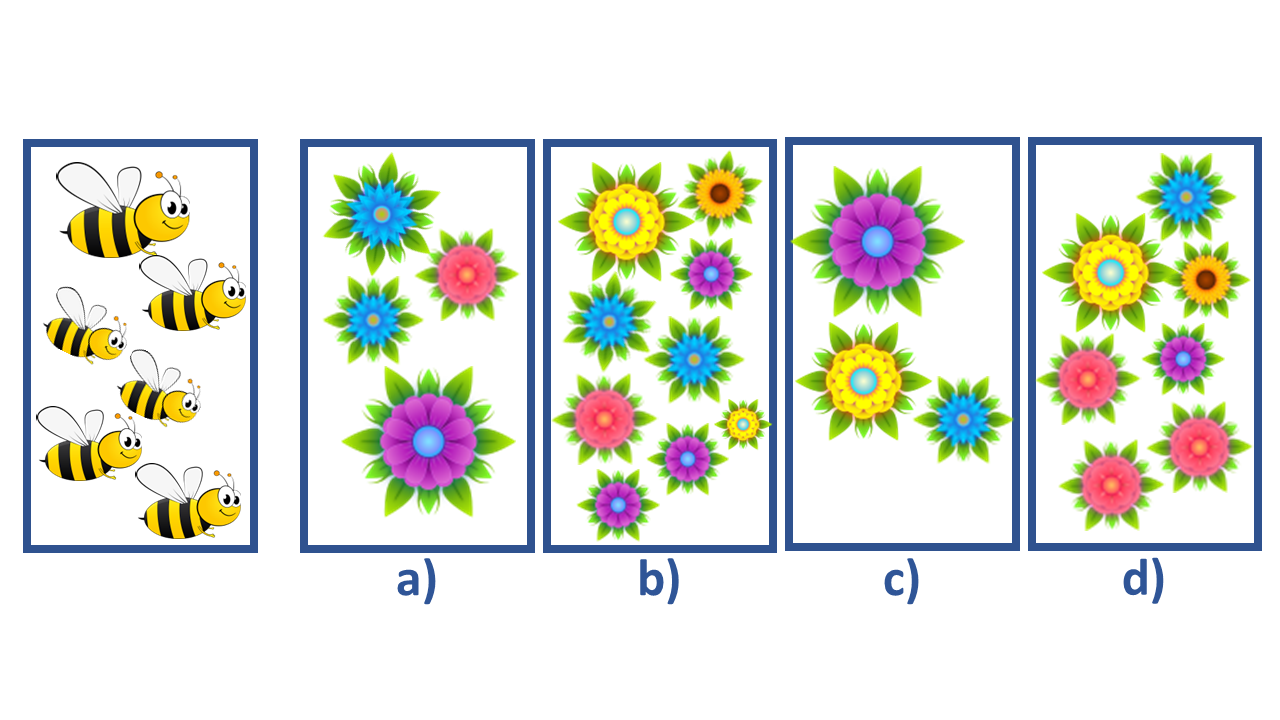
This is a Level D question:
- Look at the order of the symbols in each of the boxes. Put a checkmark next to the group of symbols below that should be in the next box.
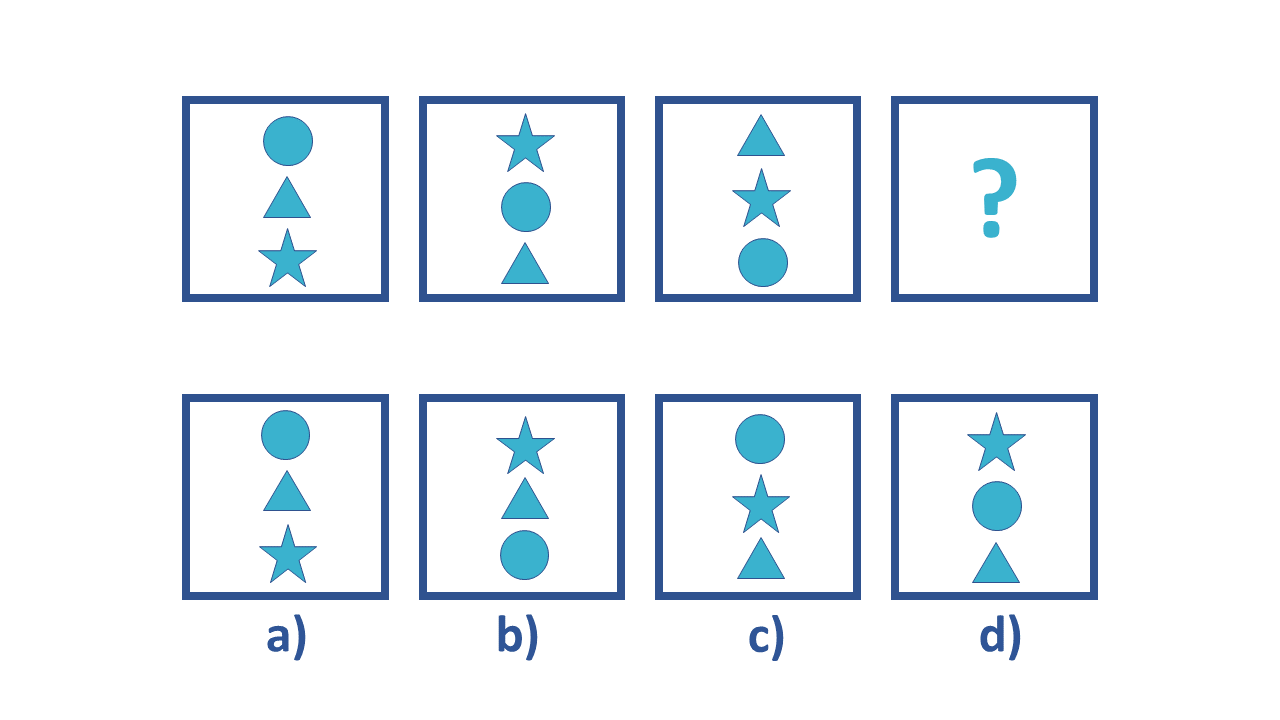
Family Membership gives you access to all the TestPrep-Online resources for the next 12 months. You will also get two separate accounts, which can be very helpful if you have two children preparing for their tests.
OLSAT Scoring
Children either can take the OLSAT online or a hard copy version with paper and pencil. Depending on the child’s age, there are either 40 questions or 60–72.
Like with most psychometric tests there are multiple scores you will need to interpret when you get the results.
Each student’s results will be given first as a raw score (how many correct answers they got in total).
For example, they could receive a score of 50 out of 72.
Then the raw score is compared against other children in the same age group to give the SAI (School Ability Index).
This SAI provides more information than just the raw score – the child’s age is important as children are measured against their peers in groups of three-month bands.
Regardless of the age of the student, the SAI has a mean average of 100. 150 is the maximum score.
Most who take the test score between 85 and 115. For most gifted programs the qualifying admission score is around 130-132 – so only the top 2% or so of the population achieve this.
You are also then given a percentile ranking for your child compared against all the others in their age group as well as in their grade.
If, for example, your child is in the 98th percentile, they scored as well as or higher than 98% of students in the same age and grade band.
There are also sub-rankings for the main sections of verbal and non-verbal.
There is no fail mark for the OLSAT.
Calculating OLSAT test scores is complicated and can take some time for each student – so be prepared for a wait of a couple of months.
How to Prepare for OLSAT Exams
Parents are key in helping their children prepare for the OLSAT.
Step 1. Know Your Child's Strengths and Weaknesses
In general, keeping abreast of your child’s strengths and weaknesses is important as you can then work out where to focus your energy.
You can also speak to the teachers at your child’s school and other parents who have gone through the process to see what their advice is.
Questions cannot be repeated once read out by the administrator, so encourage your children to develop their focus and careful listening skills. The more you practice these skills with your children, the better their confidence and performance will be.
Explaining to children why these kinds of tests can be essential to help them find self-motivation.
Step 2. Do OLSAT Practice Tests
In terms of preparation, doing pen-and-paper or online OLSAT example questions and practice tests can really help students improve their scores on the actual day through familiarization with how they need to think.
When using sample questions to practice, also use a timer.
This makes sure you are getting your children used to the idea of being timed and working against a clock.
Additionally, it means they are not working for too long at a time and becoming too tired – keeping OLSAT preparation non-stressful is essential to maintaining their motivation.
It’s worth noting that there is no penalty for students in guessing answers if they are unsure.
Therefore, explain the elimination technique: first eliminate the answers that seem most unlikely and then guess the rest if they run out of time.
Step 3. Look After Their Wellbeing
Like with all parenting, it's important to keep positive and not to put too much pressure on your children.
Encourage them to learn self-regulatory and coping skills, like deep breathing to pass through unpleasant emotions.
Ensure they are well-rested and fed before the test days too. In general, protein-rich foods for breakfast are better than sugary ones as this will avoid an energy crash before the test.
Make note of what snacks, treats, breaks and rhythms work for your children.
The OLSAT is a multiple-choice test designed to identify highly gifted children.
Preparing your children for taking the OLSAT is a good idea as it could determine their eligibility and acceptance to extra academic programs offered by their schools.
You can speak to your child’s teacher if you want them to take the OLSAT.
Only those who are expected to perform at the highest level are normally put forward for it.
It can be taken at any age so it’s best to wait until your child is mentally ready and prepared for it.
Practicing is crucial.
In terms of preparation, doing OLSAT examples can really help students improve their scores on the actual day.
When you use sample questions, make sure you are also getting them used to the idea of being timed and working against a clock.
The OLSAT test was developed by Pearson Education.
It was first devised in 1979 by creators Arthur Otis and Roger Lennon.
It’s currently in its eighth edition; the OLSAT has continually been peer-reviewed since its inception to remove any gender, ethnic, regional and cultural biases.
The most useful score for comparison that you are given after taking the test is the SAI (School Ability Index), which has an average mean of 100 regardless of the age of the student.
150 is the maximum score.
For most gifted programs the score to qualify for admission is around 130–132 – so only the top 2% of the population achieve this very high score.
It is usually group-administered for the older students.
Younger children take the OLSAT on a one-to-one basis, with an administrator reading the questions.
There is no failing score for the OLSAT.
In terms of preparation, doing OLSAT example questions and practice tests can really help you improve your score on the day.
When you look for sample questions to practice, make sure you are getting used to the idea of being timed and working against a clock.
Do some research into your strengths and weaknesses as well as which breaks, rewards and rhythms work for you, too.
In terms of online tools, doing OLSAT examples can really help students pass – so practicing is crucial.
Look for sample questions, and make sure you are getting used to the idea of being timed, and working against a clock.
Calculating OLSAT test scores is complicated and can take some time for each student – be prepared for a wait of a couple of months.
Each student’s results will be given first as a raw score (how many questions were answered correctly).
Then the raw score is compared against other children in the same age group to give the SAI (School Ability Index).
Yes, the OLSAT can be retaken by students.
There is no standardized test day for the OLSAT so you will need to enquire as to when your child’s school district normally administers the test and when the next available date is.
The OLSAT can be taken at any age – but it is best to wait until your child is mentally ready and prepared for it, so they do not get test fatigue.
Final Thoughts
Like with many childhood and academic milestones, the OLSAT is important to prepare for.
Make sure your children understand why they are taking these kinds of tests and how they can make the most of the process – and perhaps even enjoy it.
They will build their OLSAT confidence if you help them practice the format and improve their listening and focusing skills.
The OLSAT is meant to be challenging, but with help, your children will build stamina and develop their reasoning skills and ability to do their best in it.
If they score well in the OLSAT, they may qualify for gifted-and-talented programs that will further accelerate their academic progress by enabling admission to gifted-and-talented programs.



